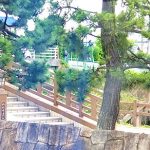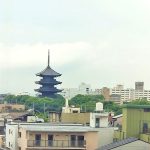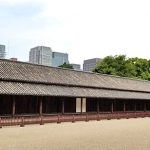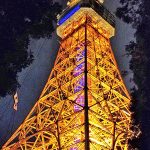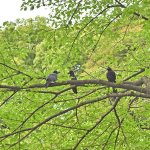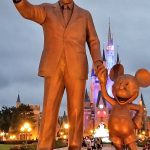Getting lost in Tokyo’s railway system
- Trees and other greenery are scattered around Tokyo with footbridges add a touch of old Japan in a modern city.
- A Shinto shrine towers above houses and other structure in an area near Tokyo.
- An old structure inside the Imperial Palace’s courtyard at the East Garden
- The Tokyo One Piece Tower at night.
- Crows and ravens fly freely in Tokyo and are not afraid to go near people.
- Walt Disney with the world’s most famous mouse.
TOKYO, Japan—For first-time travelers like me, it is easy to get lost visiting this densely populated urban jungle. A city with a population of close to 40 million, whose people are working and living in an area of about 5,000 square miles.
Just a disclaimer: this is not a travelogue or a guide on what sites to see, places to explore, and other things to do when you visit Japan. Rather a tourist recounting his experience in surviving the streets of one of the world’s busiest cities.
I have to give props to the Japanese when it comes to urban planning. Most especially, coming from a country that emerged from the destruction of the Second World War.
The Japanese has brought efficiency and urban planning to another level, a model that other countries could emulate and follow. They created a concrete jungle, without sacrificing the environment with trees and flora still found even in parks—whether big or small—and in tiny spaces scattered around the city. Their rivers and creeks are still clean, free of trash unlike in other cities like Manila where I grew up.
Their main highway—from Narita Airport to Metropolitan Tokyo—were either two or four lanes. For other byways, especially going to the AirBNB where we stayed at Minami-Koshigaya in Saitama Prefecture, they have narrow one-lane roads for cars and their public transport system, but wider sidewalks for people to walk on and ride their bikes either to work, the market, or in any destination they are heading to.
They have buses—whether limousine service or the regular ones that went around the designated routes and only stops in assigned stations—and taxi cabs that were a bit pricey compared to their railway system, which is their main mode of transportation around the Greater Tokyo Area, the 26 other nearby cities, and the mountainous region of the Nishi-Tama District in the west.
Japan is a country that loves the railway system, a somewhat dizzying maze crisscrossing the city, but also connects northern and southern areas of the country. There are instances that you need to transfer to several trains or stations in order to get to your destination.
The Tokyo Station, the main intercity terminal in the Chiyoda Marunouchi Business District, is home to the Tokaido Shinkansen or more popularly known as the high-speed bullet train.
The Tokaido Shinkansen is owned and operated by the Central Japan Railway Co. and it has three train services—the Nozomi, the fastest and has limited stops; the semi-fast Hikari; and the Kodama that stops in all stations from Tokyo to Shin-Osaka.
We rode the Nozomi line when we went to Osaka where it only took almost three hours in making the more than 500-kilometer trip from Tokyo.
Sanyo, Tohoku, Joetsu, Nagano, and Kyushu are the other lines that connect the country from the Hokkaido to the north and the southern islands of Shikoku and Kyushu. Tokyo is located in the island of Honshu. You might have to transfer or use other lines in exploring the other cities and places in the Land of the Rising Sun.
I traveled with my family, wife and two kids, and I’ve lost count on how many times we got lost in trying to find places like the controversial Yasukuni Shrine to the war dead, the beautiful red-painted Torri Gates Tunnel at Hie Shrine in Akasaka district, Diver City Tokyo Plaza, the 20-meter Unicorn Gundam statue in Odaiba, Godzilla—which has captivated our son for more than a year now—statue at the Hibiya Chanter building in Chiyoda Ward’s Yurakucho district, the Giant Sky Wheel, and the Tokyo Skytree. On the bright side, we get to see other places in Tokyo.
We walked around Shinkoshigaya in Saitama district and Nishikujo in Osaka Prefecture, visited the Tokyo Imperial Palace—didn’t get to see Emperor Akihito or any other member of the Imperial family though—saw the Tokyo skyline at night at the Tokyo One Piece Tower, and most importantly stopped by the Wizarding World of Harry Potter inside Universal Studios Japan and toured “The Happiest Place on Earth” Tokyo Disneyland.
It was a fun and learning experience for us with both of our kids enjoying the trip when we visited both theme parks—the 108-acre USJ and all 115 acres of Tokyo Disneyland where we my wife and I became kids again.



